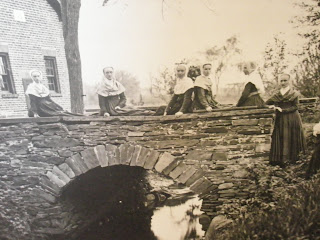Ann Lee
From Mount Lebanon we traveled west to Watervliet. There, not far from what is now the Albany Airport, Ann Lee and her small band of Shakers came in 1784. Born in Manchester, England, Ann arrived in New York with seven followers, including the husband who soon abandoned her, just as the American Revolution was breaking out. Perhaps because of her eight children,none had lived past six, Ann preached celibacy as a central tenet of the United Society of Believers in Christ's Reappearing. Rejoicing in their faith, which they expressed through ecstatic singing and dancing, Ann and her followers were pacifists and paid little heed to the war which raged with special ferocity in upstate New York.
Leasing a small piece of land in 1776, the first Shakers set to work draining the swampy ground and creating a farm. In 1780 Ann made a missionary tour of New England , attracting new followers and taking in some of the many orphans whose parents were carried off by war and disease.
On the day we visited the Shaker Village at the intersection of Heritage Lane and Meetinghouse Road in Watervliet, the only visitors were a group of developmentally delayed adults who paid close attention to the tour guide as she explained to them the purpose of the various remaining buildings.
Restored interior of the 1848 Meeting House
19th century drawing of Shakers dancing in a meeting house
As we listened to the guide, we could almost hear the lively stamp of Shakers dancing in this very space, and perhaps felt just a bit of their inner joy and peace.
Work was central to Shaker life, and their industriousness brought great prosperity to their communist societies during the first years of the American republic. Here at Watervliet, the Shakers specialized in the production of brooms and garden seeds. They also operated a cannery.
The Great Barn
Brethrens Workshop
Wash House & Cannery
In 1926 the City of Albany purchased the property and demolished several buildings. The others, however, are in good condition structurally, although their interiors are in poor repair and not open to the public.
Not far from the village, we found the cemetery where 400 of the Shakers rest eternally. Walking slowly past the plain stones, many of which attest to the advanced age common to the Shakers, we found the slightly larger stone of Ann Lee among those of her devoted followers.
My interest in the Shakers has been an historical one and I found the sect to be of interest chiefly for its subsequent influence on American life. Although the celibate group dwindled down over the years, their belief in an imminent Second Coming was shared by the Millerites, and those other uniquely American forms of millenarian Christianity like the Seventh Day Adventists, not to mention the Branch Davidians, and the Assemblies of God who play such a large part in religious and political life life today. The ecstatic form of Shaker worship, and the speaking in tongues, has also remained with us. Even the Shaker belief that the work of conversion continues on into the afterlife has long been shared by the Church of Latter Day Saints, whose origins coincided in time and place with the high point of the Shaker movement.
19th century drawing of a Shaker girl falling into a trance
Jesus Christ not only foretold the falling away, the coming of antichrist, he also foretold a reappearing, a coming again to gather and save. In his last interviews with his disciples he uttered some mysterious words, over which theological quibbling has spent itself in vain. Not to the wise nor prudent of this world came the word of revelation, but to the child in simple trust with heart of faith. The apocalypse of mystery that descended from cloud to sea at Patmos opened its meanings, when to the child spirit of Ann Lee came the call of God. We have watched her follow that call. We have seen her wrestlings and conflicts as flesh strove with spirit, as the cross, heavy and death bringing, was taken bravely up. We have watched her. as she subdued and slew the weakness and sin of her lower nature. We have heard her cries and moans of agony as the weight of a world's woe pressed upon her heart. We have watched her in prison, every nerve throbbing with the torture of that forsaken, narrow cell, where for fourteen days she was nourished by God's gift, sustained by His power. We have seen her in the prison cell in Manchester, baptized with the Christ Spirit. From that time she never faltered in her calm assurance of knowledge that to her had been given the revelation of the Maternal Spirit of God. Ann Lee always acknowledged Jesus Christ as her Lord and Savior, the Head of the Church; but, when the two anointed leaders, before whom she had confessed her sins and whom she had obeyed as her spiritual guides, recognized in her a superior endowment of Divine Maternity, and with the rest of the little circle acknowledged her as now their Spiritual Mother, she did not refuse the recognition.
Women of the Shaker community on the bridge in the Watervliet settlement
from the collection of the Watervliet Shaker Village
Although I am not usually given to any kind of mysticism, I did feel an unusual sensation when I placed my hand upon Mother Ann's stone, perhaps a presence or simply a reassurance that the divine principle of the universe is indeed a loving and maternal one.











.JPG)













